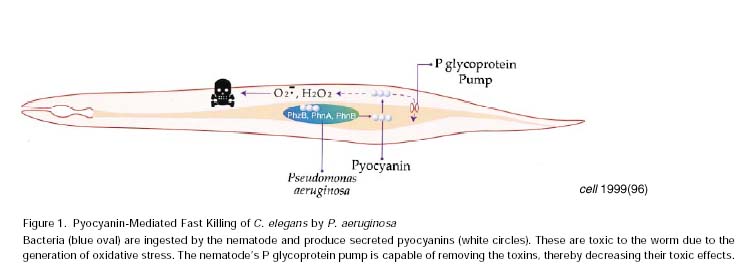Pseudomonas aeruginosa
Among the pathogens that enjoy availability of multiple hosts,
Pseudomonas aeruginosa is one of the well-studied ones. P. aeruginosa
is an opportunistic gram-negative bacteria that is capable of infecting
a broad range of both animal and plant hosts. In humans, P.aeruginosa
causes a broad spectrum of opportunistic infections and is a major cause
of bacteremia (Man-Wah et al., 1998). Studies done in Ausubel laboratory
have clearly established that various P. aeruginosa strains can also kill
C. elegens (Man-Wah et al., 1998; and Mahajan-Miklos et al., 1999).

Depending on the medium that P. aeruginosa is grown, it cause death in
C.elegans by two different ways:
(1) 'fast killing', which is induced
by a diffusible toxins that provoke an oxidative stress and death within
a couple of hours and
(2)' slow killing', which is a consequence of
bacterial infection in the worm guts and takes days instead of hours
(Man-Wah et al., 1998).
Significantly, the majority of the virulence
factors important in the fast or slow killing of C. elegans (e.g. genes toxA,
gacA and dsbA) are also implicated in the virulence of P. aeruginosa in mammalian
and plant models. Moreover, several P. aeruginosa mutants that are less virulent
in C.elegans also show hampered pathogenicity in mammalian and plant models. All
these pieces of evidence underline the existence of common virulence mechanisms
in P. aeruginosa pathogenicity in these three evolutionary-divergent hosts.
In addition, analysis of C.elegans mutants that show increased or decreased
susceptibility to slow/fast killing by P. aeruginosa has helped researches
dissectcomplex responses involved in host defence strategies (Man-Wah et al., 1998).
